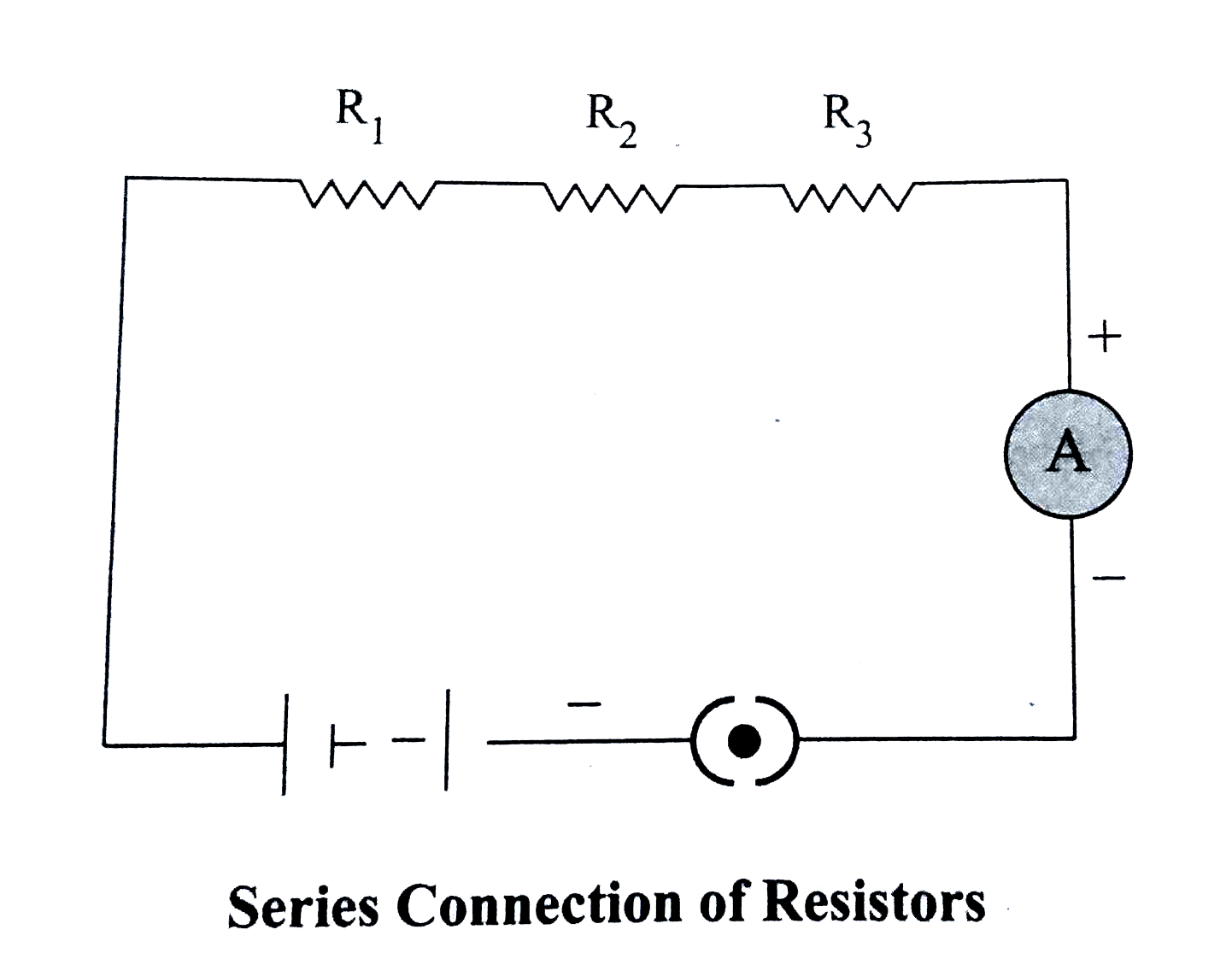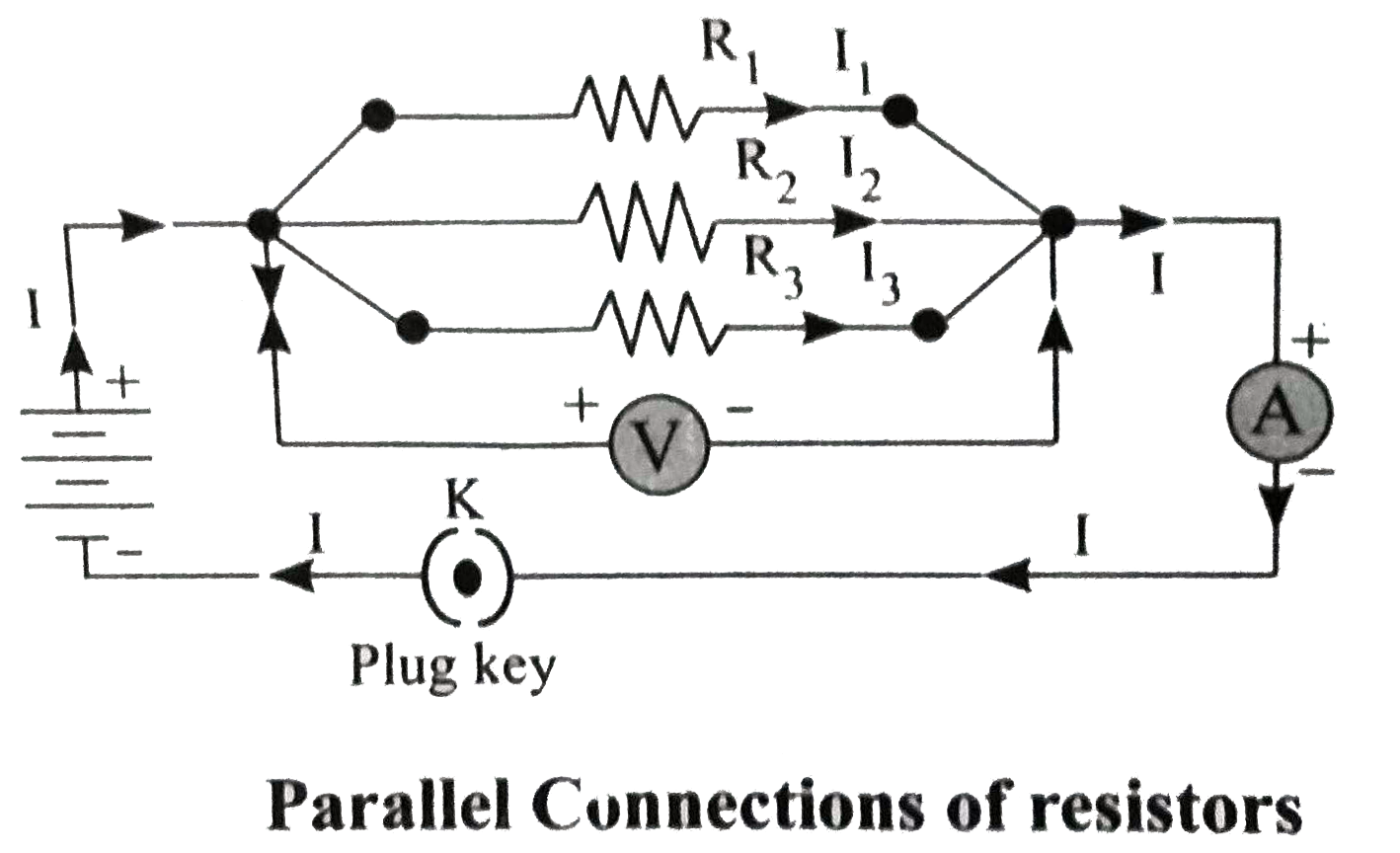With the help of a circuit diagram derive the formula for the resultant resistance of three resistance connected : (a) in series and (b) in parallel Solution in Tamil
Resisitors in series
A series circuit connects the components one after the other to form a .single loop.. A series circuit has one loop through which current can pass. If the circuit is interrupted at any point in the loop, no current can pass through the circuit and hence no electric appliances connected in the circuit will work. Series circuits are commonly used in devices such as flashlights. Thus. if
(i) Resistors are connected end to end, so that the same current passes through each of them then they are said to be connected in series.

(ii) Let, three resistance and be commected in series.
(ii) Let the current flowing through them be I.
(iv) According to Ohm.s Law the potential differences and across and
respectively, are given by :
The sum of the potential differences across the ends of each resistor is given by :
Using equations (1),(2) and (3), we get
(v) The effective resistor is a single resistor, which can replace the resistors effectively, so as to allow the same current through the electric circuit.
(vi) Let, the effective resistance of the series - combination of resistors, be . Then,
Combining equations (4) and (5)
Thus, we can understand that
(vii) When a number of resistors are connected in seies, their equivalent resistance or effective resistance is equal to the sum of the individual resistances.
(viii) When .n. resistors of equal resistance R are connected in series, the equivalent resistance is .n R..
i.e.,
(ix) The equivalent resistance in a series combination is greater than the highest of the individual resistances.
Resistors in parallel :
A parallel circuit has or more loops through which current can pass. If the circuit is disconnected in one of the loops, the current can still pass through the other loop(s)
The wiring in a house consists of parallel circuits.

(i) Consider that three resistors and are connected across two common points A and B.
(ii) The potential difference across each resistance is the same and equal to the potential difference between A and B. This is measured using the voltmeter.
(iii) The current I arriving at A divides into three brancnes and passing through and respectively.
According to then Ohm.s law, we have,
The total current through the circuit is given by
Using equations (1), (2) and (3), we get
Let the effective resistance of the parallel combination of resistors be . Then
Combining equations (4) and (5), we have
Thus,
Thus (iv) When a number of resistors are connected in parallel, the sum of the reciprocals of the individual resistances is equal to the reciprocal of the effective or equivalent resistance.
(v) When ,n, resistors of equal resistance R are commected in parallel, the equivalent resistance is
i.e.,
Hence,
(vi) The equivalent resistance in a parallel combination is less than the lowest of the individual resistance.
Topper's Solved these Questions
- ELECTRICITYBook:FULL MARKSChapter:ELECTRICITYExercise:Textual Evaluation (IX. Numerical problems )
Explore 4 Videos
- ELECTRICITYBook:FULL MARKSChapter:ELECTRICITYExercise:Textual Evaluation (XI. HOTS)
Explore 3 Videos
- ELECTRICITYBook:FULL MARKSChapter:ELECTRICITYExercise:Textual Evaluation (VII. Short answer questions)
Explore 5 Videos
- DEPARTMENTAL MODEL PAPER (SOLVED)Book:FULL MARKSChapter:DEPARTMENTAL MODEL PAPER (SOLVED)Exercise:PART-IV
Explore 6 Videos
- LAWS OF MOTIONBook:FULL MARKSChapter:LAWS OF MOTIONExercise:Additional Questions (VIII. Problems.)
Explore 2 Videos
Similar Questions
An electric iron consumes energy at the rate of 420 W when heating is at the maximum rate and 180 W when heating is at the minimum rate. The applied voltage is 220V. What is the current in each case.
View SolutionTwo resistors when connected in parallel give the resultant of 2 ohm, but when connected in series the effective resistance becomes 9 ohm ? Calculate the value of each resistance.
View SolutionDefine electric potential and potential difference.
View SolutionExplain the experiment of measuring the real and apparent expansion of a liquid with a neat diagram.
View SolutionA cricket ball of mass 0.5 kg strikes a bat normally with a velocity of 30 ms−1 and rebounds with a velocity of 20 ms−1 in the opposite direction, calculate the impulse of the force exerted by the ball on the bat.
View Solution(a) With the help of a diagram, derive the formula for the resultant resistance of these resistors connected in series. (b) For the circuit shown in the diagram given below: Calculate: (i) the value of current each resistor. (ii) the total current in the circuit. (iii) the total effective resistance of the circuit.
View Solution(a) With the help of a circuit diagram, obtain the relation for the equivalent resistance of two resistances connected in parallel. (b) In the circuit diagram shown below, find: (i) Total resistance. (ii) Current shown by the ammeter A
View Solutionएक प्रतिरोध तथा संधारित्र विधुत परिपथ में एक प्रत्यावर्ती वोल्टेज के साथ श्रेणी क्रम में जुड़े है परिपथ की प्रतिबाधा के लिए सूत्र व्यत्पन्न कीजिए ।
View SolutionWith the help of a circuit diagram derive the formula for the resultant resistance of three resistances connected:a) in series and b) in parallel.
View SolutionThe resultant resistance of n wires each of resistance r ohms is R, when they are connected in parallel. When these n resistances are connected in series, the resultant resistance will be
View Solutionपार्श्वक्रम में जुड़े, तीन प्रतिरोधों का परिपथ चित्र बनाइए। इस संयोजन के तुल्य प्रतिरोध के सूत्र की व्युत्पत्ति कीजिए।
View SolutionWith the help of a circuit diagram derive the formula for the resultant resistance of three resistances connected in series.
View Solution(a) (i) State Ohm's law.
(ii) With the help of a circuit diagram derive the formula for the resultant resistance of three resistances connected in parallel.
View Solutiona] Derive an expression for the equivalent resistance of three resistors RI, R2 and R3 connected in a parallel.
b] Fuse of 3 A, 5 A and 10 A are available, calculate and select the fuse for operating electric iron of I kW power at 220 V line.
View SolutionWith the help of a diagram derive the formula for the equivalent resistance of three resistances connected in parallels?
View Solution